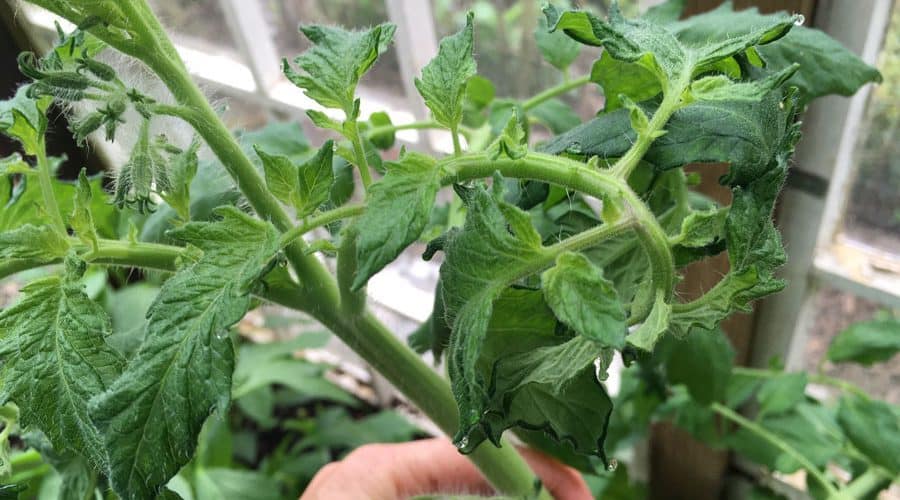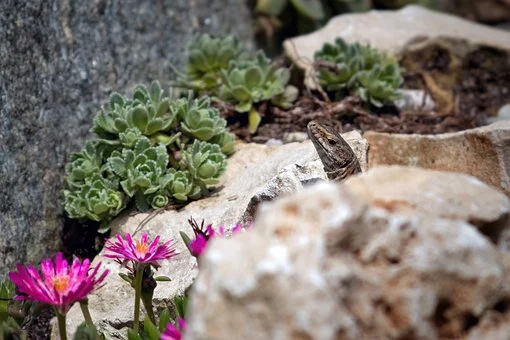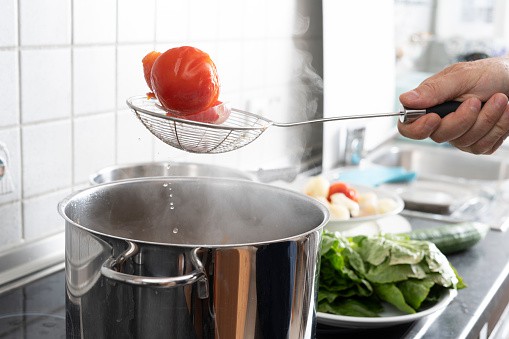When you run into tomato plant leaves, you would probably perceive them as edibles and try to make something out them. However, the issue is whether they are actually poisonous to human beings. Many people think that they are poisonous, but what has the research found? Have you never tasted tomato leaves, or used them in your cooking? We will find out.
Tomato originally is the plant in the Solanaceae family of plants informally known as the nightshade family. There are many families in which each genus contains its own alkaloids that are both toxic and non-toxic. For that reason they are widely believed to be poisonous. However, is that really true or over-exaggerated legend that is is passed around, and we take just another edible part of this plant? Let us explore the myths and decide if the tomato plant leaves are actually poisonous to humans or this is just an urban legend.
Five Common Myths Concerning the Tomato Leaves Consumption
1. Tomato plant leaves contain toxic compounds known as alkaloids.
As mentioned early, the plant usually contains alkaloids. These are the chemical components of plants that vegetables have to defend themselves from certain insects, animals, bacteria, and fungi, and we eat them every day in various doses. It is an established fact that some of the alkaloid derivatives are detrimental to your health, while others may be good or bad based on perception. Furthermore, even though alkaloids are also present in common vegetables, you will never consume them in a single meal to the point of causing their harm!
So what gives with the leaves on tomato plants?
Tomato plants contain a major glycoalkaloid called tomatine that forms the sugar-alkaloid bond. This glycoalkaloid is present at all parts of tomato like leaves, stems, and unripe ones.
According to the study published in the journal of Agricultural and Food chemistry, the highest concentrations of this compound are found in the leaves and then the stems, green fruits, fresh leaves, calyces, and roots. Nonetheless, the green fruits have a very similar nutritional content to the fresh leaves; so the say that the fruits are necessarily better is false.
Besides, glycoalkaloids are poorly absorbed in the digestive tract of mammals and thus they go out as feces or urine. As these chemicals are not well tolerated by such individuals, stomach discomfort is among the possible effects. In reality though they’d need to eat an unmanageable amount of leaves or green tomatoes in order to experience such effects.
So, are leaves on tomato plants poisonous or not?
The Toxic Plants of North America book states that for human beings to absorb a toxic dose of tomatine, they would need to consume a pound of leaves and further adds that ” the risk in most circumstances is low. ” This food safety survey (which focuses on the toxicity of glycoalkaloid compounds that are found in tomatoes, eggplants and potatoes), which has been carried out, finds tomatine to be a mild glycoalkaloid. It caused neither weight increase nor liver size enlargement in mice, so it was regarded as a friendly environment for human health.
Another research had shown the leaves and stems of tomato plants to have a higher concentration of polyphenols (a type of plant micronutrient that is good for general health and helps fight disease) and antioxidant activity than tomato fruits. Another valuable one is the discovery that tomatine is a cancer inhibitor. This glycoalkaloid that is present confers an inhibitory effect on the human breast, liver, colon, and stomach cancer cells by either killing or inhibiting their growth.
Finally, the research draws the conclusion that you might gain from eating high-tomatine green tomatos. Additionally to this effect, this “requirement” involves the creation of high-tomatine red tomatoes to study tomatine as an anti-viral anti-carcinogenic agent or cancer treatment. In other words, these findings and the lack of reliable proof that tomato leaf is deadly to humans drive us to the second myth.
2. Dogs dying after consuming tomato leaves
Was it a story you have heard in your neighborhood that a dog is dead because it ate a whole bunch of tomato leaves or green tomatoes? Should this be one of your concerns? In fact, it is fatal for a dog if it is consumed in large amounts. Consequently, the question of whether tomato plant leaves can kill a dog is a matter of dosage-dependent since you are aware dogs eat anything crazy and stop at nothing.
If your dogs are allowed to roam freely in your home garden and are not properly trained to keep off the plants, it is quite possible that they will eat all your tomatoes, including the leaves. With small pets this intake can lead to vomiting and diarrhea in the best case or ending up in the hospital in the worst cases. So do many other plants in your garden, not only the tomato plants.
So, is the toxicity level on a dog the same as humans?
On the flip side, there is another list of foods that are known to be poisonous to dogs. They include grapes, chocolate, garlic, onions, and raisins. On the contrary, the toxins that are harmful to dogs may not cause the same harm to us. Moreover, veterinary literature documents less about the toxicity of tomato leaves. In a case study from Israel, the researchers found that cows did not react negatively even when they were fed tomato leaves for about 42 days.
3. Organic farmers making tomato-leaf sprays for pest control
Tomato-leaf sprays are produced by cutting and soaking tomato leaves in water, and then using the sprays on a variety of plants to treat aphids and other pests. Knowing that tomatine is a fungicide in its own right and is also part of the tomato’s existing resistance towards pests and aphids, it follows that the compound remains effective if extracted into a solution. Nevertheless, in theory, you could extract any part of the plant, such as the stem or the root, which usually contains a higher amount of tomatine and make a spray. So, unless you are allergic to tomatoes, the tomatine in these tomato-leaf sprays cannot harm you, and that is why it is mostly used as an organically method for killing pests.
4. Tomato leaves are not sold commercially.
In Cooking by Handbook by former Chez Panisse Chef Paul Bertolli, he included a recipe for leafy tomato sauce. The No-Waste Vegetable Cookbook addresses the same issue. It has a recipe for a spicy and minty tomato sauce which contains some tomato leaves and tomato leaves pesto that tastes supreme on sandwiches and pizza. Besides those cases, there were a couple of people who indeed have owned up to their use. But that doesn’t mean that they are not edible.
The best way to use tomato leaves is as an infusion, where one can experience the smell and taste of ripe tomato. For instance, add a few leaves of tomato plants to olive oil or tomato water when you make gazpacho. You can also shred the leaves thinly and coat with fish sauce. You can, then, use it as a delicious garnish for fish or rice.
Also fried tomatoes leaves is a delicious alternative topping for pasta, just as you would fry sage leaves in browned butter. In addition, you may dry and crush tomato leaves and use them for flavouring, sprinkling over pasta or pizza.
5. Nightshades are usually very poisonous.
As was mentioned earlier, the tomato belongs to the plant family Solanaceae but gets informally called the nightshade family. Amongst a variety of species, different alkaloids can be both toxic and harmless. In the family, “deadly nightshade” or belladonna is considered to be highly poisonous to all forms of life. Nevertheless, its history of use in herbal medicine as a muscle relaxer, pain reliever, and beauty product is remarkable.
Moreover, it has got its roots in the old-fashioned habit of women putting 2 or 3 drops of belladonna berry juice for diluting of their pupils. While tomatoes are distantly associated with belladonna, they don’t have the chemical compounds that make belladonna berries so poisonous.
However, the tomato also has a rich history on its own. Its scientific name, Lycopersicum, means “wolf peach” in Latin and is a word taken from the German folklore. Consequently, when the plant was brought to Europe in the 16th century, most people perceived it as poisonous and the other Solanaceae members were the belladonna, mandrake, and henbane. Witch legend had it that they use those hallucinogenic tomato plant in potions for summoning werewolves. Therefore, since these berries looked like belladonna, they were called wolf peaches.
We are aware that these plants are part of the Solanaceae family but are not of the same genus as deadly nightshade since we consume the fruits. This ambiguity was then reflected in the tomato’s other scientific name, that is, Lycopersicon esculentum, meaning “edible wolf peach.”
Tomato Toxicity Symptoms When Consumed in Abundance.
In addition to tomatine, the tomato has a far lesser toxin called atropine. Some cases, as reported by people, suggest that they may have suffered digestive problems after eating tomatoes, particularly when combined with hot peppers. In addition, there are unconfirmed accounts of tomatine and likely arthritis. Yet, there is no unsubstantiated statement in the documentary at all. While the effects can be painful, they aren’t dangerous.
Tomato leaves have the unique, spicy scent becoming edible to most animals all being covered with prickly hairs. Nevertheless, some animals for instance dogs and cats that seem to eat anything they find around including the tomato leaves are bound to overfeed on the leaves when they are still young, which pose a danger to their health. Furthermore, the effects of tomato toxicity are usually more evident in dogs than in humans where digestive related disorders as well as neurotoxicity have been reported. Therefore, it is advisable to stay on the safer side and avoid your tomato plants to be near your canines for their safety.
Some individuals are more sensitive to the alkaloid components and they shouldn’t use them. Also people on specific dietary plans or taking specific supplements can go for advice from a nutritionist or their doctor. Those other than you may try out for the rest of us. The benefits of consuming so many tomatoes are numerous and the possibility of them being toxic is not worth considering.
Conclusion
Tomato leaves have unique taste and are edible. Young and fresh leaves can be cooked but, take precautions in order not to experience complications like diarrhea and vomiting. Combined to this, if you are on special diet plans or taking specific supplements, consult the nutritionist or doctor. Remember that tomatoes are edible, and eating them is not the only action you ought to perform. Yet, the portion plays a significant role.
Furthermore, if your dog has ingested the green parts and leaves of these plants, please look out for any ptero ovine poisoning signs and symptoms. However, some dogs, even the young ones, may excessively feed on it, therefore be vigilant.
Frequently Asked Questions About Tomato Plant Leaves
1. Are tomato leaves actually poisonous?
Yes, unless of course these are taken in small quantities since they contain a weak toxin known as tomatine that happens to be present even in some unripe tomatoes..
2. What are the main benefits of tomato plant leaves?
It has been discovered that tomato stems and leaves contain more antioxidants and polyphenols than the fruit does, and these substances prevent and combat various diseases and promote health. It also a mention that tomatine (cancer inhibitor) found by scientific research.
3. Are tomato plant leaves poisonous to dogs?
Solanine, a substance found in the stems and leaves of tomato plants and related plants, is a killer for dogs when it is consumed in large doses. Last of all, if dogs ingest any gut parts along with mushrooms, we suggest you to monitor your dog for any symptom of a toxin known as ptomaine poisoning.
4. Can tomato plant leaves kill you?
It is about how much, as mentioned previously. Imagine yourself this time eating two pounds of tomato leaves for whatever reason, and the risk of being sick is indeed there. In other words, if you eat more, the chances are high that you’ll be close to death.
5. Should I remove yellowing or dead tomato leaves?
In most situations, you remove young leaves and stems by bending them from the main stem until the break. It is always advisable to go with this method. Additionally, tomato leaves are prone to aging quickly, and the green fruits receive the most sun; therefore, the withered, yellow leaves must be removed to allow the fruit to ripen.
















